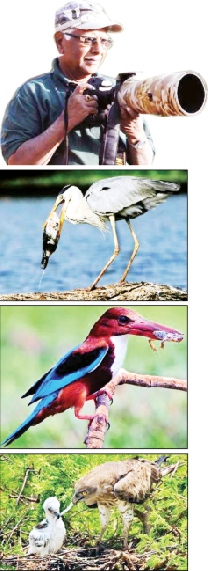 City’s eminent cinematographer & photographer, S. Thippeswamy, in a candid conversation…
City’s eminent cinematographer & photographer, S. Thippeswamy, in a candid conversation…
One photograph published in one daily newspaper, the photographer immediately poses and puffs smoke rings and claims that he is a professional photojournalist, wildlife photographer and more,” commented city’s eminent cinematographer and wildlife photographer S. Thippeswamy, with a wry smile on his face.
This and other candid comments are made at an impromptu addaa sessions deep in the basement of ‘Ramsons House’ in city.
The prickly subject of professional photographers and their art came up when someone present commented on the great annual Pinhole Camera Photography contest conducted by a top professional photography magazine in USA and top photographers from across the globe test their skills using a handmade cardboard pinhole camera!
“To use an ordinary box camera or pinhole camera to photograph people or places, that is the mark of a true professional,” says Thippeswamy. “A thorough knowledge of light, composition and most important of all, the ability to see the photograph in the mind’s eye, the third eye. If I were to ask today’s professionals, then they will ask, ‘What is a pinhole? Who is pinhole …?’ such is their ignorance…” says Thippeswamy.
R.G. Singh of Ramsons Kala Pratishtana in a brief tete-a-tete with Thippeswamy. Excerpts…
R.G. Singh (RGS): “One swallow does not a summer or (is it spring?) make…” Similarly one or even several photographs published here and there does not make one a true professional…” Like Jiddu Krishnamurthy would often say in his talks, can we go a little deeper into this issue?
S. Thippeswamy: It took me more than 30 years of continuous learning process and I am still learning even to this day. Photography is much more than just a sophisticated camera that does all the work for you. The true photographer is one who has been drawn to this field because he has a passion and the commitment to make it a lifelong mistress!
RGS: As you have done so… made photography your lifelong mistress !
Thippeswamy: (Laughs) Yes, a very jealous mistress! passion and commitment, Sir, passion and commitment! There is romance in photography. You learn the art of composition, the play of light and shade… a vision forms in your mind and that is where the first photograph is created in your mind …even before you click the shutter.
RGS: You have to be a technician too, right ?
Thippeswamy: The old box cameras required human expertise. I still have my old Voigtländer camera and several others too like the Brownie wherein you had to check the focal length, aperture speed and so on and then the actual taking of the picture. It needs a keen eye, the ability to see the picture in the mind’s eye. Photography is a lifelong love affair. If it isn’t there, then what you will get is just a picture. (Laughs)
RGS: Then the films had to be sent for processing …?
Thippeswamy: After all that work, the films would be sent to be processed and then till the finished prints arrived you would never know how the photographs would turn out… Of course, later I began making the prints myself in my dark room.
RGS: From being a professional photographer for magazines and brochures to wildlife, how did this transition occur?
Thippeswamy: I have previously done corporate photography and industrial photography too. They needed a different perspective, the advertising angle. The photographs had to sell the product. The image had to be eye-catching, only then would the customer read the text. The photographs of people and places to illustrate magazine and newspaper articles also needed a different perspective. Wildlife and nature photographs need solid discipline — to blend with nature and the animal’s habitat. It takes years to mature as a nature and wildlife photographer. I have done more than 200 documentaries and have got four national awards.
RGS: One documentary which impressed you most?
Thippeswamy: In 1972, I made a documentary on tribes like Kaadu Kurubas, Jenu Kurubas and Soligas for the Information Department which was well received. This was a documentation of the lives of these tribes for their rehabilitation from core forest areas. Interviews with them, documenting their lifestyle and their closeness to nature and wildlife… it was a lot of effort, but worth it. I have also made documentaries for the Central Institute of Indian Languages and the Abdul Nazir Sab Institute for Rural Development (ANSIRD). I also made nine short films for ANSIRD. All of them were greatly appreciated.
RGS: When did you take to jungle trails?
Thippeswamy: You see, I did not become a wildlife photographer overnight. I was a member of the camera unit of several film studios including Kanteerava Studios for years before I moved on to a career as a photographer for the Mysore Medical College. Around this time, it was in 1979 that I began photographing the monuments and heritage buildings of the city and some of them were published in a few dailies. They were spotted by journalist M.B. Singh who was then the Editor of Sudha and Prajavani. M. B. Singh, who I consider my Godfather, gave me several assignments.
A fellow professional who had seen my work one day challenged me to photograph wildlife which he said was more difficult. Thus in 1981, I took up wildlife photography as a challenge as this particular field requires several attributes, like patience, using whatever light is available and not frightening the subject. Animals are wary of humans and to click them without arousing any nervousness in them is an art that has to be learnt and no textbook can teach you that… I have covered all wildlife reserves and national parks in the State and most across the country.
RGS: One last question… your advice to the budding photographers?
Thippeswamy: First, it is an expensive profession. Do you have the financial ability to live off your work? The equipments like cameras, lenses, etc., are expensive, can you afford them? Can you afford to spend days in difficult conditions without basic necessities? Can you spend time away from your job, family for days? If the answer is positive to all these questions, only then should you should become a photographer. Let your photographs do the talking. Do not become mere posers !
— R.G. Singh
Awards & Fellowships
‘Lifetime Achievement in Photojournalism’ by Karnataka Media Academy; Bharatiya Vidya Bhavan’s ‘E. Hanumantha Rao Lifetime Award’ for achievements in wildlife photography; ‘Raghavendra Chitravani’ Award for film and TV work , Public Relations Council of India (PRCI), Bangalore Chapter’s ‘Samvahana Award,’ for contribution to wildlife photography. Fellowship of the Photographic Society of America (2005); Proficiency Distinction for the Nature category (2005); Award for Best Thematic Nature photography by UNESCO supported Federation of International De L’Art Photography (1995) and Fellowship of The British Royal Photographic Society (1992).
source: http://www.starofmysore.com / Star of Mysore / Home> Feature Articles / by R. G. Singh / December 18th, 2013







